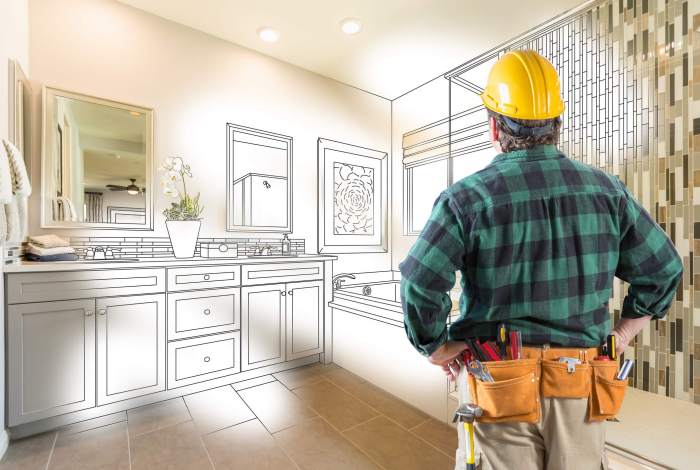Find Home Improvement Contractors: A Guide to Success

Find home improvement contractors, and you’re embarking on a journey to transform your living space. Whether you’re dreaming of a stunning kitchen renovation or a cozy backyard oasis, the right contractor can turn your vision into reality. However choosing the right professional is crucial, as a poorly executed project can lead to frustration, financial burdens, and even safety hazards.
This guide will equip you with the knowledge and strategies to navigate the world of home improvement contractors, ensuring a smooth and successful experience.
From understanding the importance of licensing and insurance to effectively vetting potential contractors, we’ll explore the key steps involved in finding the perfect fit for your project. We’ll delve into crucial considerations like experience, reputation, and communication skills, empowering you to make informed decisions that align with your needs and budget.
The Importance of Choosing the Right Contractor
Your home is likely your most valuable asset, so it’s crucial to protect it by choosing the right contractor for any home improvement project. Hiring the wrong contractor can lead to costly mistakes, delays, and even safety hazards.
Potential Consequences of Hiring the Wrong Contractor
Hiring an unqualified or unreliable contractor can have serious consequences, including:
- Poor workmanship: This can lead to problems that require costly repairs or replacements in the future. For example, a poorly installed roof could lead to leaks, mold growth, and structural damage.
- Project delays: An unreliable contractor may not show up on time or complete the work within the agreed-upon timeframe, leading to frustration and inconvenience.
- Cost overruns: Unqualified contractors may underestimate the cost of materials or labor, resulting in unexpected expenses.
- Safety hazards: Improperly installed electrical wiring, plumbing, or structural work can create safety hazards for you and your family.
- Legal issues: In some cases, a contractor’s negligence could lead to legal action if someone is injured on your property due to their work.
Common Home Improvement Scams and How to Avoid Them
Unfortunately, home improvement scams are prevalent. Here are some common scams and how to avoid them:
- “Too good to be true” deals: Be wary of contractors who offer extremely low prices, especially if they pressure you to sign a contract immediately. They may use low-quality materials or cut corners to make a profit.
- “Bait and switch”: A contractor may offer a low price for a specific service, but then try to upsell you on additional work once they’re on your property. Always get a detailed written estimate before agreeing to any work.
- “Advance payment scams”: Be cautious of contractors who demand a large upfront payment, especially before any work has begun. A reputable contractor will typically require a small deposit, but not the entire project cost upfront.
- “High-pressure sales tactics”: If a contractor uses aggressive sales tactics or makes you feel pressured to make a decision quickly, it’s a red flag. Take your time, get multiple quotes, and don’t be afraid to walk away if you feel uncomfortable.
Checking Contractor Licenses and Insurance
- Licensing: Most states require contractors to be licensed, so check with your local building department or licensing board to ensure the contractor you’re considering is properly licensed. A valid license indicates that the contractor has met certain standards of training and experience.
- Insurance: Reputable contractors carry general liability insurance and workers’ compensation insurance. This protects you from being held responsible for any accidents or injuries that occur on your property during the project. Ask for proof of insurance before hiring a contractor.
Finding and Vetting Contractors

Finding the right contractor for your home improvement project is crucial for a successful outcome. A thorough vetting process ensures you select a skilled and reliable professional who will deliver quality work within budget and on schedule.
Utilizing Online Resources
Online platforms and directories are valuable resources for finding qualified home improvement contractors. They offer a wide range of options, allowing you to compare profiles, read reviews, and contact potential contractors directly.
- HomeAdvisor: A popular platform that connects homeowners with pre-screened contractors. HomeAdvisor provides detailed profiles, customer reviews, and project estimates.
- Angie’s List: A subscription-based service that offers ratings and reviews of local contractors. Angie’s List also provides background checks and guarantees on services.
- Houzz: A platform focused on home design and renovation. Houzz features a directory of contractors, along with portfolios, client testimonials, and project photos.
- Yelp: A widely used platform for reviews of businesses, including contractors. Yelp provides user-generated reviews, photos, and business information.
- National Association of the Remodeling Industry (NARI): A professional organization that provides a directory of certified remodelers. NARI members adhere to a code of ethics and are committed to quality craftsmanship.
When using online platforms, it is important to consider the following:
- Read reviews carefully: Pay attention to both positive and negative feedback to get a balanced perspective.
- Check for licensing and insurance: Ensure the contractor is licensed and insured in your state or region.
- Verify contact information: Ensure the contact information provided is accurate and up-to-date.
- Look for professional websites: A well-maintained website indicates professionalism and commitment to the business.
Interviewing Potential Contractors
Once you have identified a few potential contractors, it is essential to interview them thoroughly. This step allows you to assess their qualifications, experience, and communication skills.
- Prepare a list of questions: Ask about their experience, expertise in your specific project, project management process, and communication style.
- Request references: Contact previous clients to inquire about their experience with the contractor.
- Discuss project details: Clearly Articulate your project scope, timeline, and budget expectations.
- Review contracts carefully: Ensure the contract includes all project details, payment terms, and warranties.
Gathering Quotes
It is recommended to obtain quotes from multiple contractors to compare pricing and services.
- Provide detailed project specifications: Ensure each contractor receives the same information to ensure accurate and comparable quotes.
- Request itemized breakdowns: Understand the cost of labor, materials, and permits.
- Compare quotes carefully: Consider factors beyond price, such as experience, reputation, and communication style.
Key Considerations When Choosing a Contractor
Choosing the right contractor for your home improvement project is crucial to ensure a successful and satisfactory outcome. It involves more than just finding someone who can do the job; it’s about finding a contractor who is reliable, skilled, and committed to delivering quality work.
This section will delve into the key factors to consider when evaluating potential contractors, helping you make an informed decision.
Experience and Expertise, Find home improvement contractors
It’s essential to choose a contractor with experience in the specific type of work you need. A contractor with a proven track record in similar projects is more likely to understand the challenges and complexities involved, ensuring a smoother and more efficient process.
Inquire about the contractor’s years of experience, the types of projects they have completed, and their specialization. For example, if you’re planning a kitchen renovation, look for a contractor with extensive experience in kitchen remodeling.
Reputation and Testimonials
A contractor’s reputation is a strong indicator of their reliability and quality of work. Check online reviews on websites like Angie’s List, HomeAdvisor, and Yelp to get insights from previous clients. Look for consistent positive feedback regarding professionalism, communication, workmanship, and overall customer satisfaction.
“It’s always wise to gather multiple perspectives before making a decision. Check for a balance between positive and negative reviews, and look for patterns or recurring themes in the feedback.”
Communication Skills
Effective communication is essential throughout the entire project. Choose a contractor who is responsive, clear, and transparent in their communication. This includes promptly answering your questions, providing regular updates, and being accessible for discussions. Good communication helps prevent misunderstandings, ensures everyone is on the same page, and fosters a collaborative working relationship.
Contractor Portfolios and Previous Work
Requesting a portfolio or examples of the contractor’s previous work is a valuable step in the evaluation process. This allows you to visually assess the quality of their craftsmanship and understand their design aesthetic. Look for projects that are similar in scope and style to your desired outcome.
Pricing Models and Contract Terms
Understanding different contractor pricing models and contract terms is crucial to avoid surprises and ensure financial clarity.
Pricing Models
- Hourly Rate: This model charges based on the number of hours worked. It can be advantageous for smaller projects or those with variable scope. However, it can be challenging to accurately estimate the total cost upfront.
- Fixed Price: This model involves a predetermined total cost for the project, based on a detailed scope of work. It provides more predictable budgeting but requires a clear and comprehensive project plan.
- Cost Plus: This model involves reimbursing the contractor for actual costs incurred, plus a predetermined percentage or fixed fee for their services. It offers flexibility for unexpected changes but can lead to higher costs if not managed effectively.
Contract Terms
- Scope of Work: Clearly define the project scope, including all tasks, materials, and specifications. Avoid ambiguity to prevent disputes later.
- Payment Schedule: Establish a clear payment schedule, outlining milestones and corresponding payments. Consider including provisions for progress payments and final payment upon project completion.
- Warranty and Guarantees: Understand the contractor’s warranty and guarantee policies for materials and workmanship. This provides protection against defects or issues that may arise after project completion.
- Change Orders: Define the process for managing project changes, including procedures for approvals, cost adjustments, and timelines.
- Dispute Resolution: Specify a method for resolving any disagreements or disputes that may arise during the project. This could include mediation or arbitration.
The Contract and Project Scope: Find Home Improvement Contractors
A comprehensive and detailed contract is crucial for a successful home improvement project. It serves as a legally binding agreement that Articulates the project’s scope, timeline, budget, and responsibilities of both parties. A well-defined contract protects your interests and minimizes the risk of disputes or misunderstandings.
Essential Contract Clauses
It is essential to include specific clauses in the contract to ensure clarity and protection for both parties. These clauses provide a framework for managing the project effectively and resolving any potential issues that may arise.
- Project Scope: A clear and detailed description of the work to be performed, including materials, finishes, and specific details. This should be accompanied by detailed drawings or specifications.
- Timeline and Completion Dates: Establish a realistic timeline for the project, including start and completion dates, and any potential milestones. This helps manage expectations and allows for tracking progress.
- Payment Schedule: Define the payment terms, including the total project cost, payment milestones, and any applicable deposits or retainers. This ensures transparency and avoids payment disputes.
- Warranty and Guarantees: Include provisions for warranties on materials and workmanship, outlining the duration and scope of coverage. This protects you from potential defects or faulty work.
- Change Orders: Establish a process for managing changes to the project scope, including how to document, approve, and adjust the contract price and timeline.
- Dispute Resolution: Specify a method for resolving any disagreements or disputes that may arise during the project. This could include mediation, arbitration, or legal proceedings.
- Insurance: Ensure the contractor carries adequate liability insurance and workers’ compensation coverage. This protects you from potential financial losses in case of accidents or injuries.
Defining and Documenting the Project Scope
The project scope defines the specific work to be performed, including materials, finishes, and any other relevant details. This detailed documentation ensures that both parties understand the project’s expectations and prevents misunderstandings or disputes later.
- Detailed Specifications: Provide detailed descriptions of materials, finishes, and specific requirements for each element of the project. For example, specify the type of flooring, paint colors, and cabinet hardware.
- Drawings and Plans: Include accurate drawings or plans that depict the project scope, dimensions, and layout. This ensures a shared understanding of the final design and construction.
- Photographs and Samples: Use photographs and physical samples to illustrate specific materials, finishes, and design elements. This helps visualize the final result and avoids potential misinterpretations.
- Communication and Documentation: Maintain clear and consistent communication throughout the project, documenting all decisions, changes, and approvals in writing. This helps track progress and resolve any issues that may arise.
Managing the Project

Successfully managing a home improvement project with a contractor requires a clear understanding of the process and a proactive approach. This involves establishing effective communication channels, setting realistic expectations, and being prepared to address potential challenges.
Project Management Strategies
A well-defined project management strategy is crucial for ensuring the project stays on track and meets your expectations. Here are some key steps to consider:
- Develop a Detailed Project Plan: A comprehensive plan Artikels all project phases, timelines, milestones, and budget allocations. This serves as a roadmap for both you and the contractor, ensuring everyone is aligned on the scope and expectations.
- Establish Regular Communication Channels: Frequent communication is essential. Schedule regular meetings or calls with the contractor to discuss progress, address concerns, and make necessary adjustments. Utilize clear communication channels like email or project management software to document all discussions and decisions.
- Set Realistic Expectations: Understand that unexpected delays or issues can arise during construction projects. Be prepared to adjust the schedule or budget if necessary. Communicate openly with the contractor and work together to find solutions.
- Monitor Progress Regularly: Regularly visit the project site to assess progress and identify any potential issues early on. Take photos or videos to document the work as it progresses, which can be helpful for future reference.
- Keep Detailed Records: Maintain a thorough record of all project documents, including contracts, invoices, change orders, and communication logs. This documentation will be essential for tracking expenses, resolving disputes, and ensuring project accountability.
Effective Communication and Collaboration
Open and transparent communication is fundamental to a successful project. It fosters trust and allows for prompt resolution of any issues that may arise.
- Active Listening: Pay attention to the contractor’s explanations and concerns. Ask clarifying questions to ensure you understand their perspective and proposed solutions.
- Clear and Concise Communication: Use plain language and avoid jargon when communicating with the contractor. Be specific in your requests and expectations to minimize misunderstandings.
- Respectful Dialogue: Maintain a professional and respectful tone throughout the project, even when disagreements arise. Approach challenges as opportunities for collaboration and problem-solving.
- Document Everything: Keep a record of all communication, including emails, phone calls, and meeting notes. This documentation can be invaluable if disputes or disagreements arise.
Handling Delays and Unexpected Issues
Delays and unexpected issues are common in home improvement projects. It is important to be prepared to handle these situations effectively.
- Anticipate Potential Issues: Consider the possibility of unforeseen challenges, such as material shortages, weather delays, or hidden structural problems. Discuss these potential issues with the contractor during the planning stage and establish contingency plans.
- Address Issues Promptly: If a delay or issue arises, communicate with the contractor immediately. Discuss the problem, identify potential solutions, and agree on a revised timeline or budget if necessary.
- Document All Changes: Any changes to the original project scope, timeline, or budget should be documented in writing through a change order. This ensures transparency and accountability for all parties involved.
- Seek Professional Advice: If you encounter significant challenges or disagreements with the contractor, consider seeking professional advice from a qualified mediator or construction lawyer.
Payment and Project Completion

As your home improvement project nears completion, it’s crucial to understand the payment process and ensure a smooth handover. This section Articulates common payment methods, the significance of final inspections, and tips for resolving any potential issues.
Payment Methods and Schedules
Payment schedules are a key aspect of any home improvement project. They provide a clear understanding of when payments are due and how they are structured. Common payment methods and schedules include:
Milestone Payments: This method involves making payments at specific stages of the project, such as after foundation work, framing, or completion of the roof.
This approach allows for progress to be tracked and ensures the contractor is compensated for work completed.
Progress Payments
These payments are made at regular intervals, such as weekly or bi-weekly, based on the percentage of work completed. This approach provides a more consistent flow of funds for the contractor.
Lump Sum Payment
A single payment is made at the project’s completion. This method is often used for smaller projects with well-defined scopes of work.
Retainer
A portion of the total project cost is paid upfront to secure the contractor’s services. This can be particularly helpful for larger or more complex projects.
Note:It’s important to discuss payment terms with the contractor before signing any contract and ensure that they are clearly Artikeld in the agreement.
Final Inspections and Project Acceptance
Final inspections are conducted by local authorities to ensure the project meets building codes and safety standards. They are crucial for obtaining the necessary permits and ensuring the project is completed to a satisfactory standard.
Pre-Inspection Checklist: Before the final inspection, review the project with the contractor to ensure all work is completed according to the agreed-upon specifications.
Inspection Process
Once the inspection is scheduled, be present to address any issues or concerns the inspector may have.
Project Acceptance
After the inspection is passed, review the completed project with the contractor to ensure all aspects are satisfactory.
Final Payment
Once the project is accepted, make the final payment to the contractor, ensuring all invoices and receipts are properly documented.
Tip:Keep detailed records of all payments made, including dates, amounts, and payment methods. This documentation can be helpful in resolving any potential disputes.
Resolving Disputes
Despite careful planning and communication, disputes may arise during a home improvement project. Here are some tips for resolving them:
Open Communication: Try to resolve any issues through open and respectful communication with the contractor.
Mediation
If direct communication fails, consider seeking mediation from a neutral third party to facilitate a resolution.
Legal Action
As a last resort, legal action may be necessary to resolve disputes, but this should be considered only after exhausting all other options.
Remember:It’s essential to document all communications and agreements with the contractor, including any changes to the project scope or payment schedule. This documentation can be crucial in resolving any disputes that may arise.
Conclusive Thoughts
Finding the right home improvement contractor is an investment in your home and your peace of mind. By following the strategies Artikel in this guide, you’ll be well-equipped to navigate the process with confidence, ensuring a successful project that meets your expectations and enhances your living space.
Remember, thorough research, effective communication, and a well-defined contract are the cornerstones of a positive home improvement experience.
Comments are closed.